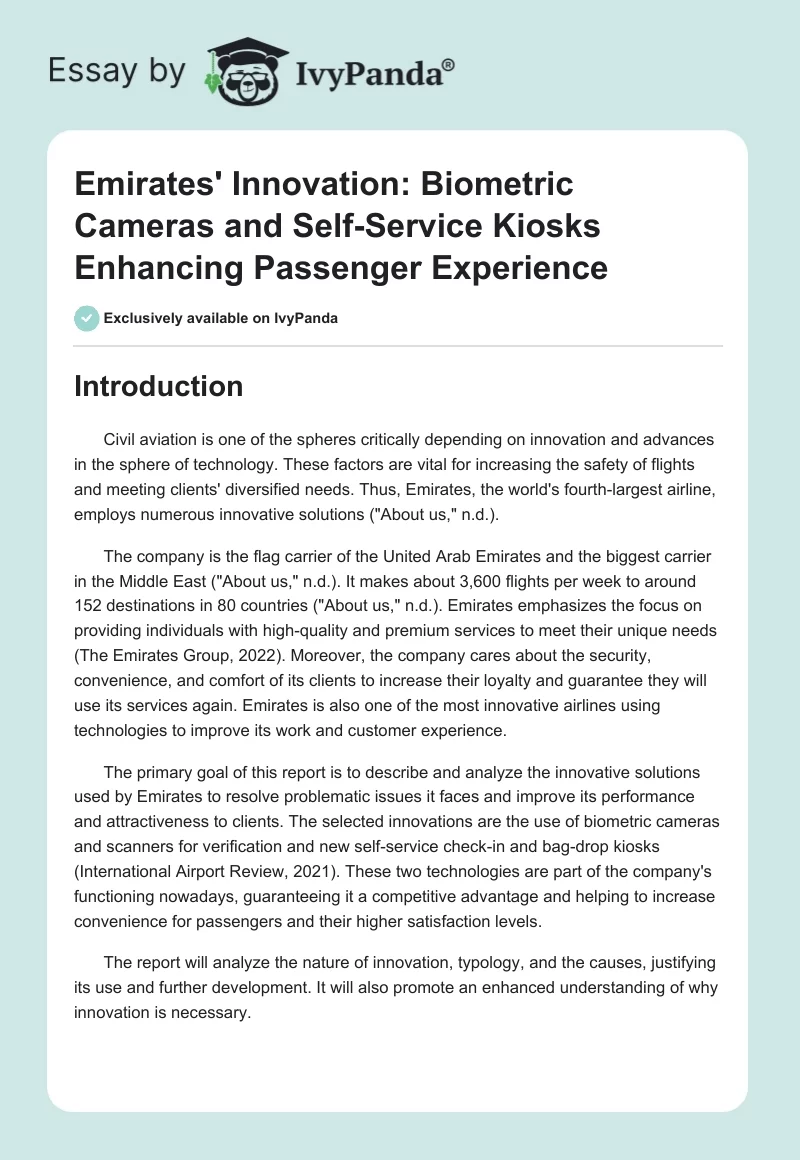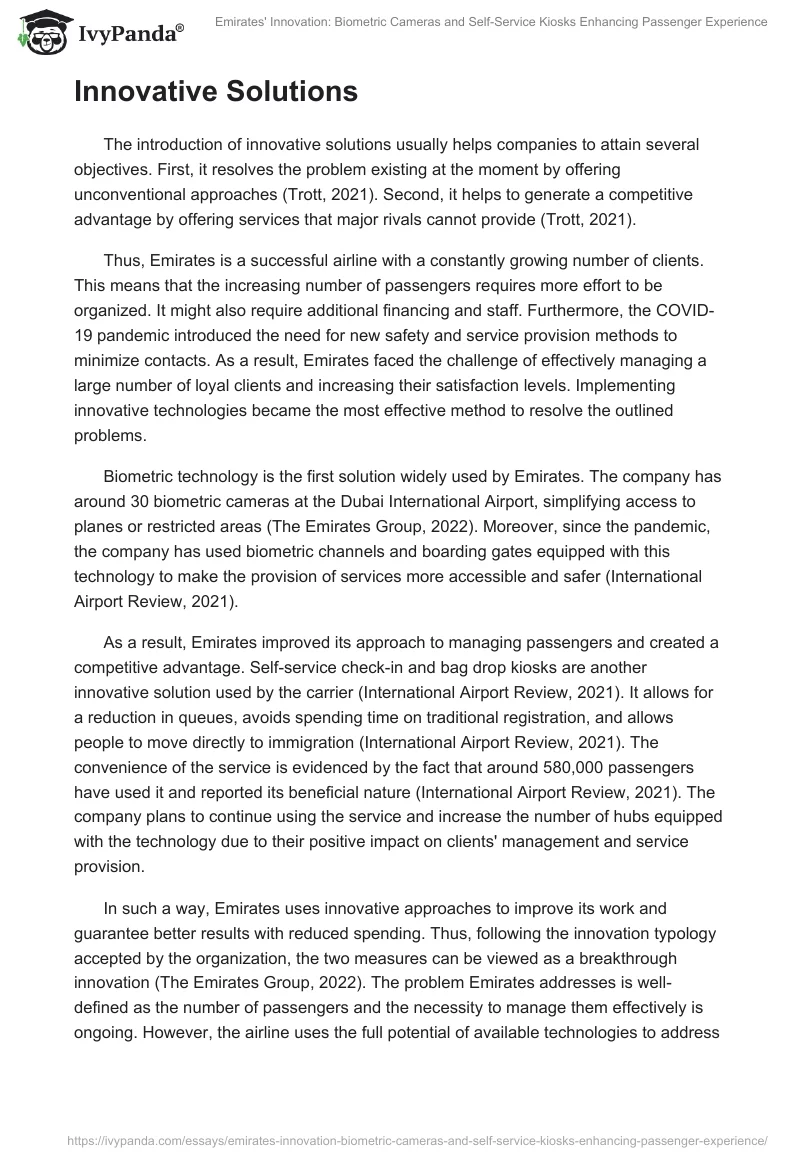Introduction
Civil aviation is one of the spheres critically depending on innovation and advances in the sphere of technology. These factors are vital for increasing the safety of flights and meeting clients’ diversified needs. Thus, Emirates, the world’s fourth-largest airline, employs numerous innovative solutions (“About us,” n.d.).
The company is the flag carrier of the United Arab Emirates and the biggest carrier in the Middle East (“About us,” n.d.). It makes about 3,600 flights per week to around 152 destinations in 80 countries (“About us,” n.d.). Emirates emphasizes the focus on providing individuals with high-quality and premium services to meet their unique needs (The Emirates Group, 2022). Moreover, the company cares about the security, convenience, and comfort of its clients to increase their loyalty and guarantee they will use its services again. Emirates is also one of the most innovative airlines using technologies to improve its work and customer experience.
The primary goal of this report is to describe and analyze the innovative solutions used by Emirates to resolve problematic issues it faces and improve its performance and attractiveness to clients. The selected innovations are the use of biometric cameras and scanners for verification and new self-service check-in and bag-drop kiosks (International Airport Review, 2021). These two technologies are part of the company’s functioning nowadays, guaranteeing it a competitive advantage and helping to increase convenience for passengers and their higher satisfaction levels.
The report will analyze the nature of innovation, typology, and the causes, justifying its use and further development. It will also promote an enhanced understanding of why innovation is necessary.
Innovative Solutions
The introduction of innovative solutions usually helps companies to attain several objectives. First, it resolves the problem existing at the moment by offering unconventional approaches (Trott, 2021). Second, it helps to generate a competitive advantage by offering services that major rivals cannot provide (Trott, 2021).
Thus, Emirates is a successful airline with a constantly growing number of clients. This means that the increasing number of passengers requires more effort to be organized. It might also require additional financing and staff. Furthermore, the COVID-19 pandemic introduced the need for new safety and service provision methods to minimize contacts. As a result, Emirates faced the challenge of effectively managing a large number of loyal clients and increasing their satisfaction levels. Implementing innovative technologies became the most effective method to resolve the outlined problems.
Biometric technology is the first solution widely used by Emirates. The company has around 30 biometric cameras at the Dubai International Airport, simplifying access to planes or restricted areas (The Emirates Group, 2022). Moreover, since the pandemic, the company has used biometric channels and boarding gates equipped with this technology to make the provision of services more accessible and safer (International Airport Review, 2021).
As a result, Emirates improved its approach to managing passengers and created a competitive advantage. Self-service check-in and bag drop kiosks are another innovative solution used by the carrier (International Airport Review, 2021). It allows for a reduction in queues, avoids spending time on traditional registration, and allows people to move directly to immigration (International Airport Review, 2021). The convenience of the service is evidenced by the fact that around 580,000 passengers have used it and reported its beneficial nature (International Airport Review, 2021). The company plans to continue using the service and increase the number of hubs equipped with the technology due to their positive impact on clients’ management and service provision.
In such a way, Emirates uses innovative approaches to improve its work and guarantee better results with reduced spending. Thus, following the innovation typology accepted by the organization, the two measures can be viewed as a breakthrough innovation (The Emirates Group, 2022). The problem Emirates addresses is well-defined as the number of passengers and the necessity to manage them effectively is ongoing. However, the airline uses the full potential of available technologies to address it and promote positive change by employing technologies. It helps to increase clients’ satisfaction levels and guarantees they are ready to use the firm’s services again.
Sustaining vs. Disruptive Innovation
Speaking about innovations, it is also essential to understand their nature and the goals of using new technologies. At the moment, there are two different types of innovation: sustaining and disruptive. The first one can be determined as the product or service improving the experience for the incumbent customers (Trott, 2021). The technology can be breakthrough or incremental in nature; however, they are focused on processes critical for clients (Trott, 2021).
Disruptive innovation is the use of technologies to find cheaper, faster, more convenient, and more effective ways of providing services to future clients (Trott, 2021). The significant difference between these two approaches is that the first focuses on already existing clients, while the second is oriented toward future groups.
When analyzing the solutions used by Emirates, it is possible to state that they represent sustaining innovation. Several factors can justify this statement. First, the services are already broadly used by numerous passengers who admit their convenience. Moreover, the innovations emerged as a response to the growing number of clients and the need for effective management.
This means that Emirates focuses on meeting the demands of loyal and already existing customers in order to generate a competitive advantage and succeed. Moreover, the company transforms already existing procedures to guarantee they can meet the diversified clients’ demands (The Emirates Group, 2022). It also evidences the sustaining nature of innovation and Emirates’ focus on addressing already existing problems by employing technologies.
Conclusion
Altogether, Emirates is one of the biggest airlines globally, with thousands of clients using its services daily. For this reason, it uses innovation as one of the major tools to attain success and create the basis for further evolution. The biometric scanners, self-service check-in, and bag drop kiosks lead to better passenger management and enhanced outcomes. The organization employs sustaining innovation, focusing on existing clients to improve their experiences. Technologies help the Emirates to remain one of the leaders in the sphere and attract new clients.
References
About us. (n.d.). Emirates. Web.
The Emirates Group. (2022). Annual report 2021-2022. Web.
International Airport Review. (2021). Emirates accelerates digital innovation for passengers. Web.
Trott, P. (2021). Innovation management and new product development (7th ed.). Pearson.


